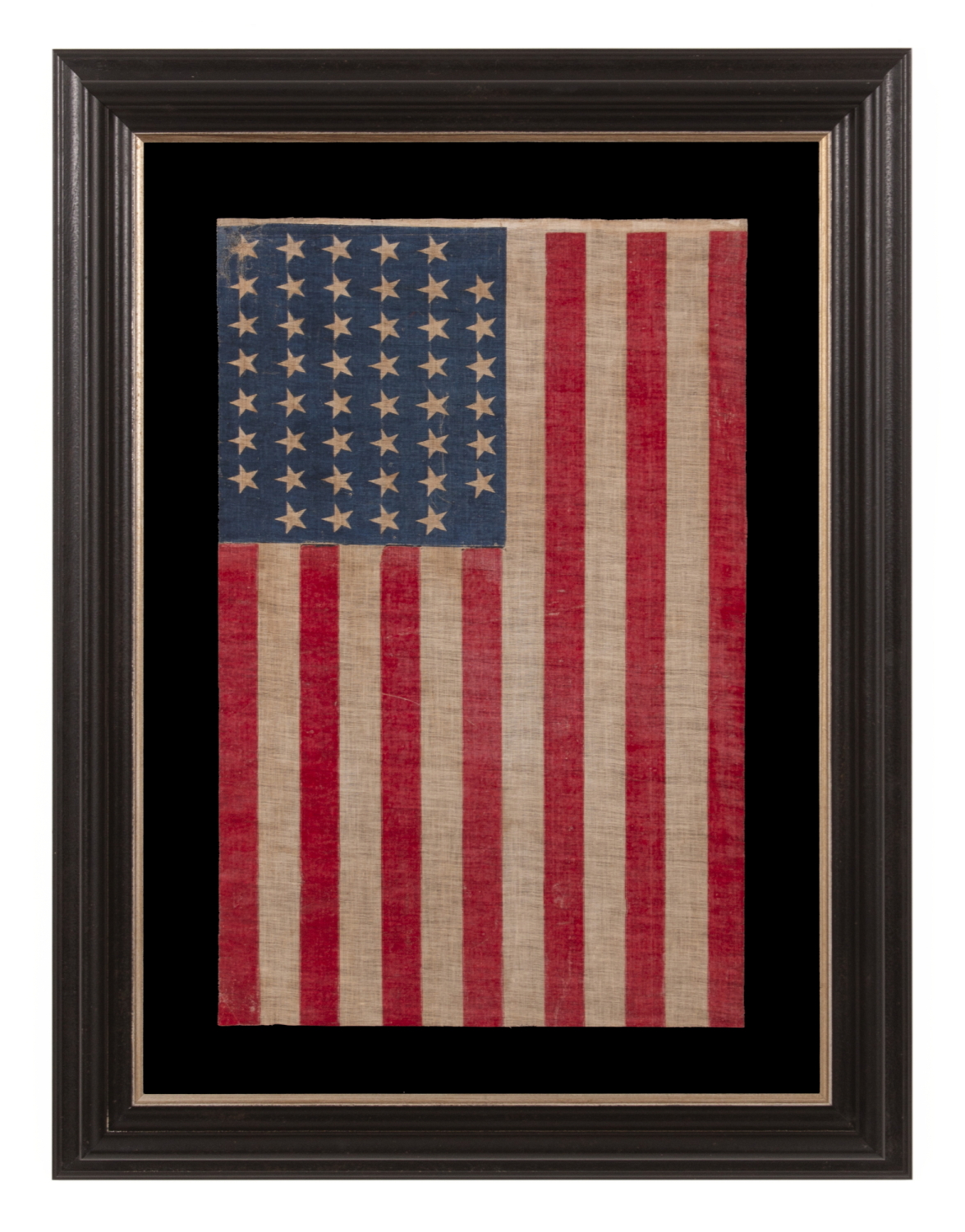


| 45 STAR ANTIQUE AMERICAN PARADE FLAG WITH ITS STARS ARRANGED IN A NOTCHED PATTERN THAT LEAVES 3 SPACES OPEN FOR THE REMAINING WESTERN TERRITORIES THAT HAD YET TO BE ADDED; REFLECTS THE ADDITION OF UTAH AS THE 45TH STATE, 1896-1908 |
|
| Web ID: | 45j-1014 |
| Available: | In Stock |
| Frame Size (H x L): | 39.25" x 29.25" |
| Flag Size (H x L): | 27.75" x 18.25" |
| Description: | |
| 45 star American national flag, printed on coarse, glazed cotton. When Utah finally entered the Union as the 45th state on January 4th, 1896. it had been attempting to gain statehood for many years. It remained a territory primarily due to the fact that the Mormon Church and Utah authorities continued to be openly tolerant of polygamy. In 1890, Mormon Church President Wilford Woodruff published a manifesto that denounced the contract of “any marriages forbidden by the law of the land,” which gave way to Utah’s acceptance. Due to the Spanish-American War (1898) and Teddy Roosevelt’s famous world tour of the “White Fleet” (launched in 1907), the tenure of the 45 star flag occurred within an extremely patriotic period of early American history. According to the Third Flag Act, enacted by Congress on April 4, 1818, stars were to be added on Independence Day following a state's addition. Flag makers didn't generally care what was official, however, so while the 45 star count because official on July 4th, 1896, and remained so until until July 3rd, 1908, it would have generally fell from production by flag-makers both professional and at home, when Oklahoma gained statehood on November 16th, 1907. Evidence of the eagerness for further Westward expansion can be seen in the “notched” configuration of stars, which leaves 3 open spaces for the addition of Oklahoma, New Mexico, and Arizona. Earlier in the 19th century, the complement of territories, their names, borders, and potential for statehood were less certain than they were by 1896. After the Dakota Territory entered as two separate states in 1889, the remainder of the path was easier to predict. For this reason, one will find 44 star flags with 4 notches for additional states, and 46 star flags with 2 notches, preceding the future count of 48 that was achieved in 1912. Notched patterns appear in earlier flags, as well, but not with the correct number of spaces to reach a sum of 48 states in the continental union. In addition to the historical interest of the notched design, note the vibrant royal blue of the canton and how it contrasts nicely with the scarlet red stripes. The flag’s overall patina from obvious use lends heavily to its graphic appeal. Presidents who served during this period were Democrat Grover Cleveland, in his second, non-consecutive term, the two terms of Republican William McKinley, the second of which was cut short by his assassination (shot 09/06/1901, passed 09/14/1901), and the two terms of Theodore Roosevelt, the first of these attained by ascension. Mounting: For 25 years we have maintained a specialized department for this purpose. Our lead conservator holds a master's degree in textile conservation from one of the nation’s top programs. We take great care in the mounting and preservation of flags and related textiles and have preserved thousands of examples. The black-painted molding with its wide, Serpentine profile and gilded inner lip, is Italian. The flag has been hand-stitched to its background, which is 100% cotton twill, black in color, that has been washed and treated for colorfastness. The glazing is U.V. protective acrylic (Plexiglas). Feel free to contact us for more details. Condition: there is minor to modest soiling throughout. There is minor misprinting in the canton. There is modest loss in the upper corner of the Canton. Fabric of the same. Was placed behind this area for masking purposes, during the mounting process. The colors are terrific and the flag presents beautifully. Many of my clients prefer early flags to show their age and history of use. |
|
| Video: | |
| Collector Level: | Intermediate-Level Collectors and Special Gifts |
| Flag Type: | Parade flag |
| Star Count: | 45 |
| Earliest Date of Origin: | 1896 |
| Latest Date of Origin: | 1908 |
| State/Affiliation: | Utah |
| War Association: | 1898 Spanish American War |
| Price: | Please call (717) 676-0545 or (717) 502-1281 |
| E-mail: | info@jeffbridgman.com |
 |
|